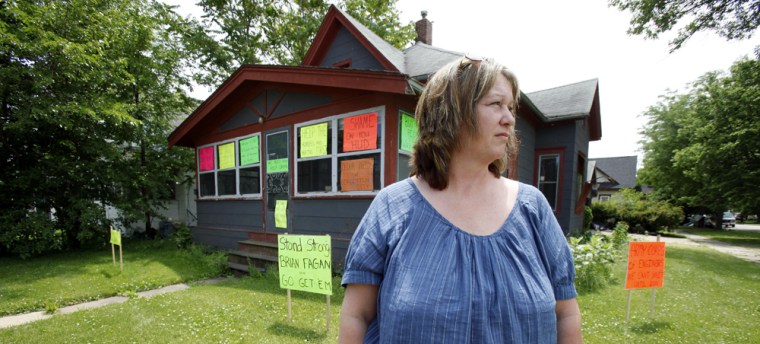Jaylynn Banks and her family have moved four times since the Cedar River burst its banks last June and flooded a huge swath of Cedar Rapids, including their neighborhood.
Their home, like those of hundreds of others here, is too damaged to inhabit, so they pay rent along with their mortgage, all on an annual income of about $20,000 after taxes. With their living situation in constant flux, Banks said they've been living day-to-day, unable to plan for the future.
"A lot of families have future plans. We're going to do this this summer. We're going to do this next year. We cannot do that," said Banks, who has pasted colorful signs, including one reading "Obama, please help us," in and around her damaged home.
Since the June 13, 2008, flood, which was among the most destructive natural disasters in U.S. history, most Cedar Rapids residents have been able to renovate, rebuild or move on.
'Hanging on by their fingernails'
But a hole in the government's disaster relief net has left many residents deep in debt and more than 1,000 households still waiting to learn what will happen to their damaged homes. For many, the emergency cash they received has dried up and long-term assistance has yet to kick in, leaving them holding mortgages for unusable homes.
"People are literally hanging on by their fingernails. They're paying two mortgages in many situations on a ruined house or a house that no longer exists," said Karla Goettel, founder of a local flood-relief organization.
The U.S. Department of Housing and Urban Development, which oversees long-term community rebuilding, announced $3.7 billion in new disaster grants for 11 states Wednesday, including $516 million for Iowa. That money will help, but Iowa's still far short of the $8 billion to $10 billion in aid state officials estimate is needed for recovery, including more than $5 billion for Cedar Rapids alone.
The flooding engulfed about 10 square miles of Cedar Rapids and swamped more than 5,000 residential properties in an area where an estimated 18,000 people lived or worked.
State officials estimate they need $150 million to buy out the 1,041 properties in three of the worst affected areas, each with its particular issues and eligibility for federal money.
Frustration over funds
The Federal Emergency Management Agency quickly stepped in to provide flood victims with emergency cash. Banks said the $11,000 the agency gave her family paid for clothing, food and shelter and got them through what was otherwise a miserable year.
But FEMA scaled back its assistance after the immediate crisis had passed and the long-term assistance has been slow to materialize.
"We are using funding streams that are not designed for disaster recovery," said Lt. Gen. Ron Dardis, executive director of the state's Rebuild Iowa Office. "When we have a disaster recovery and folks in affected areas need help and need assistance, it's very difficult to make these funds work in a timely manner."
Cedar Rapids city manager Jim Prosser said he was frustrated by the pace of rebuilding.
"You can see at times there's people from different federal and state agencies sitting in a room just to tell you what you can't do," he said. "As opposed to saying, here's the system and here's how to essentially work your way through a recovery and reinvestment as quickly as you would like. We've been sitting on our hands waiting for federal money for buyouts for over six months now."
New laws, new system
HUD Secretary Shaun Donovan, who visited Cedar Rapids on Wednesday to announce the new disaster relief grants, acknowledged that the gap between immediate and long-term assistance is a problem. But he said his agency would work this summer to streamline the process and speed it along.
"Congress for every single disaster has created a new law and a new allocation system that then takes us time to respond," he said.
Of the three hardest-hit areas, the area closest to the river will be turned into a park and its 192 properties are eligible to be bought out by FEMA.
In the second area, which is a bit farther from the river, all 377 houses will likely be destroyed to make room for a levee. But the Army Corps of Engineers hasn't decided on its placement, and may not until December 2010, leaving homeowners with as much as 18 more months of waiting.
"Right now there's some things that don't even involve HUD and housing, but where's the Corps going to suggest that the next levee go or stuff like that," said Iowa Sen. Charles Grassley said. "It's just that you can't say where you're going to buy homes out until you decide how much of the city you're going to protect from the next flood."
Residents with homes in the third area, a working-class neighborhood with 664 homes, including the Banks', will be allowed to remain, but many don't have the resources to renovate or rebuild. Residents have been told to wait up to six more months before the city will know if it has enough money to buy them out.
"That's just cruel to people," Banks said. "Even though we have a nice rental property right now and we're making it, we're still in the flood every day because we still have that house. We cannot move out underneath that shadow until that buyout takes place."
